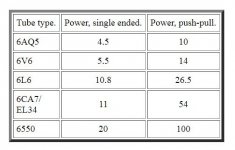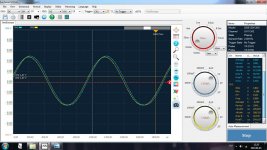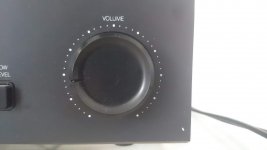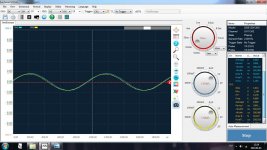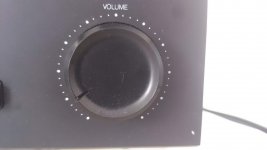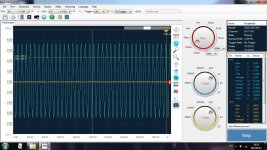Hi, I also need your advise, because I also want to build my first tube amp. Mostly I'm listening acoustic music (jazz, blues, rock) in my Cambridge Audio SX-60 bookshelf speakers (8 Ohm). The source is DAC (AD1865 NOS, or TDA1543 NOS) My current amp is NAD 3020, but I want to build better sounding 🙂 My budget is around 400-500$. Could somebody recommend a well documented design for beginner. I found some projects:
EL34 Baby Huey Amplifier
A Beginner 6BQ5 SE Amp | audioXpress
Building a Valve Amplifier Part 2: Single Channel Prototype and Loudspeakers Assembly
https://www.rs-online.com/designspark/building-a-valve-amplifier-part-1-design-components-and-layout
Thanks Gaszto
EL34 Baby Huey Amplifier
A Beginner 6BQ5 SE Amp | audioXpress
Building a Valve Amplifier Part 2: Single Channel Prototype and Loudspeakers Assembly
https://www.rs-online.com/designspark/building-a-valve-amplifier-part-1-design-components-and-layout
Thanks Gaszto
This is the right forum to ask that question! Welcome!Hi,
I also need your advise, because I also want to build my first tube amp.
You can continue in this thread; 'New Here' or start a new thread..perhaps something like 'Beginner tube amp for 89dB speakers?'
You will get more responses with a better thread title, in my opinion (IMO).
Those are listed as 89dB sensitivity. How big is your listening space? (Speaker Sensitivity, room volume and how loud you like music will tell you how powerful your amp needs to be...)Mostly I'm listening acoustic music (jazz, blues, rock) in my Cambridge Audio SX-60 bookshelf speakers (8 Ohm).
Good; you won't need a phono preamp so a simple power amp and volume control will be enough?The source is DAC (AD1865 NOS, or TDA1543 NOS)
No guarantees on the 'better sounding' but it will be more fun to listen to something you have built, and glowing tubes look excellent! 🙂My current amp is NAD 3020, but I want to build better sounding 🙂
That may be enough for something low-powered. The transformers are the expensive part - you should look for a supplier nearby if possible to reduce the shipping costs.My budget is around 400-500$.
The Tubelab SSE or SPP would be possibilities.Could somebody recommend a well documented design for beginner.
Have a look at the Mullard projects:
http://www.sowter.co.uk/pdf/Mullard-Circuits-for-Audio-Amplifiers.pdf
The RH 84 is popular and I have built a few (first version) using very ordinary output transformers and they sounded OK.
RH Amplifiers: RH84 amplifier - revision 2
The EL84 Baby Huey might be cheaper to build? I don't know if the PCBs for the EL34 version are still available?I found some projects:
EL34 Baby Huey Amplifier
That's a RH84 build in 'prototype' style... not my recommended method!!
I'm listening on moderate sound level (around 70-80dB) in a relatively small room around 20m2. I read somewhere that generally tube amps sounds better (less distortion) at low volume level compared to transistor amps.Those are listed as 89dB sensitivity. How big is your listening space? (Speaker Sensitivity, room volume and how loud you like music will tell you how powerful your amp needs to be...)
Yes, it will be enoughGood; you won't need a phono preamp so a simple power amp and volume control will be enough?
Yes there are some GB so It is available. But what is preferred EL84 or EL34?The EL84 Baby Huey might be cheaper to build? I don't know if the PCBs for the EL34 version are still available?
What is the difference?
Gaszto, Paul Joppa has provided us with a useful rule of thumb, for mating amps and speakers. Joppa's Rule state that in a "typical" listening space an amp/speaker combo should be capable of producing 102 dB. SPL peaks at a 1 M. distance. Applying that rule to the claimed 89 dB. sensitivity tells us that upwards of 16 WPC will be needed.
I checked the spec's for the speakers and found them to be incomplete. 🙁 Nothing was provided about the impedance curve. If those speakers have dips in the curve, especially in the power hungry bass region, the sensitivity has to be derated. Dips down to 4 Ω require derating to 86 dB. My "gut feeling" is that you will be better placed building something capable of 30+ WPC. The obvious candidates for the job are the EL34 and 7591.
Some discussion of the EL34 has already taken place. I suggest you scan the archives for "El Cheapo Grande", which is 7591 based.
I checked the spec's for the speakers and found them to be incomplete. 🙁 Nothing was provided about the impedance curve. If those speakers have dips in the curve, especially in the power hungry bass region, the sensitivity has to be derated. Dips down to 4 Ω require derating to 86 dB. My "gut feeling" is that you will be better placed building something capable of 30+ WPC. The obvious candidates for the job are the EL34 and 7591.
Some discussion of the EL34 has already taken place. I suggest you scan the archives for "El Cheapo Grande", which is 7591 based.
I did a try an i wrote to the technical support maybe I will have an impedance curve 🙂
Because I'm a mechanical engineer with basic electronic knowledge (this will be another learning project after the TDA1543 DAC) what is the best practice? Designing a pcb or just connect with wires? Could you recommend transformers what are available in Europe? Any help, detail, Bom list, pcb design, photo would be appreciated 🙂
Because I'm a mechanical engineer with basic electronic knowledge (this will be another learning project after the TDA1543 DAC) what is the best practice? Designing a pcb or just connect with wires? Could you recommend transformers what are available in Europe? Any help, detail, Bom list, pcb design, photo would be appreciated 🙂
Since you are just starting, I would probably recommend a push pull EL34 or KT-88 amp. There are tons of different EL34/KT-88 schematics floating around out there, and if you run into issues you should be able to find help pretty easily.
DIYaudioprojects has some stuff on its site. I recommend you check them out.
As far as transformers go, you have several options. Lundahl, AE Europe, Monolith Magnetics, possibly audio note if the ever sell to consumers again, sowter, and many more.
DIYaudioprojects has some stuff on its site. I recommend you check them out.
As far as transformers go, you have several options. Lundahl, AE Europe, Monolith Magnetics, possibly audio note if the ever sell to consumers again, sowter, and many more.
Could you recommend transformers what are available in Europe?
Sowter (UK), Bartolucci (Italy), and Lundahl (Sweden) rate to be budget busters. Toroidy (Poland) may be your best bet.
Amplifier type (SE vs PP) and tube type set the 'basics' for power output.But what is preferred EL84 or EL34?
What is the difference?
This diagram is from designing an amplifier which you might find interesting reading, even if you are choosing a tested design.
EL84 is similar to 6V6.
Download some tube manuals - the info you need about different tubes is there.
Sylvania tube manuals ONLINE!
The 'higher power' tubes tend to cost more, but more important, require bigger transformers, so everything gets more expensive in a hurry.
Attachments
I'm listening on moderate sound level (around 70-80dB) in a relatively small room around 20m2.
Gaszto, Paul Joppa has provided us with a useful rule of thumb, for mating amps and speakers. Joppa's Rule state that in a "typical" listening space an amp/speaker combo should be capable of producing 102 dB. SPL peaks at a 1 M. distance. Applying that rule to the claimed 89 dB. sensitivity tells us that upwards of 16 WPC will be needed.
............. My "gut feeling" is that you will be better placed building something capable of 30+ WPC.
Well, so far you have gotten suggestions from ~3-4 W per channel (WPC) (RH84) to 30 WPC.
🙂
Can you measure the power output from your present amplifier at the speakers at typical listening volumes you like, in your room? (Scope or good AC meter, with some test tones as input?)
I have a listening room similar in size to yours and I have played 6V6 Musical Machine (6-8 watts) and RH84 (3-4 watts) into Rega Camber 2.5 (90dB?) speakers and had adequate volume levels. Both amplifiers could drive the speakers to sound levels that led to complaints of: 'The people walking down the street can hear your music!' from my spouse, when I did the 'How loud can it go?" testing. 🙂
Some North American listening spaces are very large, so perhaps the Joppa rule of thumb is designed for that?
I agree on the Lundahl prices. And, they are extremely ugly with exposed connections so will need extra ($) transformer covers. (I recently ordered a pair of OTs for my Byrith EL34 project.)Sowter (UK), Bartolucci (Italy), and Lundahl (Sweden) rate to be budget busters. Toroidy (Poland) may be your best bet.
Even the Toroidy choices aren't cheap, though I only had a quick look.
For a total budget of $5-600 I'm interested to see some specific recommendations. I don't think that amount of money is going to get to a 30WPC amplifier without a well-stocked parts shelf on hand.
Ok, it looks like there are a lot of possibilities. For narrowing the result I want to build
EL34 based Baby Huey or 7591 based El Cheapo Grande. Are there any sound difference between the two type?
And thanks for the literature, I start reading it. Not to easy to choose from a lot of different design.
EL34 based Baby Huey or 7591 based El Cheapo Grande. Are there any sound difference between the two type?
Ok, thanks tomorrow I try measure with scope. What I have to measure? RMS voltage at the output?Can you measure the power output from your present amplifier at the speakers at typical listening volumes you like, in your room? (Scope or good AC meter, with some test tones as input?)
And thanks for the literature, I start reading it. Not to easy to choose from a lot of different design.
I'm not sure of the best way to do that measurement - perhaps others will suggest a good method.Ok, thanks tomorrow I try measure with scope. What I have to measure? RMS voltage at the output?
The scope or AC meter will give you an approximate voltage at the speaker terminals.
The problem is (as Eli pointed out) that the speaker impedance isn't constant at different frequencies- we cannot assume it is '8 ohms'.
If I were doing this measurement, I'd probably use test tones with the speakers connected, and adjust the amplifier volume control to a 'loud' setting - similar to the loudest music level. Then, (without changing the volume control on the amplifier) shut off the amplifier and disconnect the speakers and connect 8 or 10 ohm power resistors instead of the speakers. Power up the amplifier for a minute or two and measure the voltage across the resistor. Then calculate the power.
It won't be exact, but at least you will know whether you need 2W or 20W for normal listening.
Having 'too much power' isn't a huge problem if money isn't important.....
Hi,
I did the measurement with 7.5Ohm power resistor. I've attached the measurements. The test signal was 1kHz, and I did two measurement: Max, meaning the volume level, usually It is too load for me and maybe for the Negihbours too🙂 The normal is the normal listening level.
- The RMS voltage at the Max 3.3V at the normal level it is 1.2V RMS. If I calculate the Power (VRms*VRms/R) At the max level it's 1.45W At the normal level its 0.18W??
I also measured the speaker with a multimeter and I've measure 4Ohm. The nominal impedance is 8Ohm.
- I also did the measurement with this setup, (the scope was connected parallel with the speaker) the Normal level RMS is 0.9V and the calculated power (0.9*0.9/4) is 0.2W, with the Max level the RMS is 2.5V the calculated power (2.5*2.5/4) is 1.56W.
Based on the measurements, I think 3WPC will be enough for me. What do you think?
I did the measurement with 7.5Ohm power resistor. I've attached the measurements. The test signal was 1kHz, and I did two measurement: Max, meaning the volume level, usually It is too load for me and maybe for the Negihbours too🙂 The normal is the normal listening level.
- The RMS voltage at the Max 3.3V at the normal level it is 1.2V RMS. If I calculate the Power (VRms*VRms/R) At the max level it's 1.45W At the normal level its 0.18W??
I also measured the speaker with a multimeter and I've measure 4Ohm. The nominal impedance is 8Ohm.
- I also did the measurement with this setup, (the scope was connected parallel with the speaker) the Normal level RMS is 0.9V and the calculated power (0.9*0.9/4) is 0.2W, with the Max level the RMS is 2.5V the calculated power (2.5*2.5/4) is 1.56W.
Based on the measurements, I think 3WPC will be enough for me. What do you think?
Attachments
my PP 6V6 Gt with B+ of 345v and opt of 7.5k likes my 88dB Inkel sh-900 speaker. very loud sand i like it too. they used to be driven by my SS amps.
Even if you double that power requirement to 6W, it will still open up a lot of possibilities for lower-power (cheaper) amplifiers. So i would think you have more options now.Based on the measurements, I think 3WPC will be enough for me. What do you think?
My experience:
-the first amplifier is not 'perfect' for a lifetime, for all rooms and speakers
-most people who are interested in the electronics hobby do not stop with one amplifier. Usually the problem becomes: 'What will I do with these 'extra' amplifiers I have built?' 🙂
😀 Yes I know hard to stop after one build. I have been built a lot of slightly different version of TDA1543 DAC. 1 TDA1543, 2 parallel, 4 parallel, with and without Low Pass Filter...
I found this thread and I very interested in:
Building something better with a Chinese SE EL34B Amp DIY Kit
Exactly what I'm thinking about. What was you budget? Could you tell me about the sound of the amp?
By the way, I have found an interesting article about the speaker impedance curve, I want to measure it in this way.
Loudspeaker impedance measurement using a multimeter and 2 resistors
I found this thread and I very interested in:
Building something better with a Chinese SE EL34B Amp DIY Kit
Exactly what I'm thinking about. What was you budget? Could you tell me about the sound of the amp?
By the way, I have found an interesting article about the speaker impedance curve, I want to measure it in this way.
Loudspeaker impedance measurement using a multimeter and 2 resistors
Last edited:
That Chinese re-build was some years ago - I bought a 'kit' and then used a different circuit with the same components. It's still working fine, and I used it every day for a few years.I found this thread and I very interested in:
Building something better with a Chinese SE EL34B Amp DIY Kit
Exactly what I'm thinking about. What was you budget? Could you tell me about the sound of the amp?
I don't have 'golden ears', so to me, all good amps sound OK! 🙂
Quite a few people here have built Boyuu A9 (SE EL34) 'kit' amps. I looked at the prices on AliExpress and you can get one of them already completed (and tested) for only a few dollars more than the 'kit' so that would take some of the 'fun' out of that project for me, unless I was changing the circuit. A 'kit' does get you the chassis and the transformers; you might want to use a bit better (eBay, not 'audiophile' $$$) speaker and input jacks if the provided ones aren't very good.
I've also built a 6V6 PP Musical Machine (Audiotropic Eric Kingsbury aka Pointz), several RH84 EL84SE amps, and a Bruce Heran EL84 Poddwatt which sounds good to me and is my current listening amp- though I think some of the experts here don't like that design very much.
Poddwatt: Class-A Stereo Push-Pull EL84 (6BQ5) Vacuum Tube Amplifier
Some folks prefer the 'look' of the fatter 'octal' tube amps (EL34, 6L6GT or 6V6GT with 6SN7 or similar preamp tubes) vs the EL84 and 12A..7 tubes.
Now you have much too many choices!
More power= bigger transformers = more $$
SE= fewer power tubes but more expensive output transformers than PP
More 'hifi'= bigger and better output transformers= more $$
For me, I built some tube amps then I concentrated on getting some good high-efficiency speakers which made a big difference.
If you are interested in a PCB-based amp, I'd recommend the Tubelab amps as they have excellent support from George Anderson (tubelab) here, and also from many other builders. (See the Tubelab Vendor sub-forum and the tubelab website)
😀 Yes I know hard to stop after one build. I have been built a lot of slightly different version of TDA1543 DAC. 1 TDA1543, 2 parallel, 4 parallel, with and without Low Pass Filter...
Back to the amp. What is your recommendation based on the power level?
EL34 or EL84 based? PP or SE?
By the way, I have found an interesting article about the speaker impedance curve, I want to measure it in this way.
Loudspeaker impedance measurement using a multimeter and 2 resistors
Well its hard to say because your budget is sort of hard to figure out.
Do you have 500 USD to spend or 500 Euro? I am going to assume you mean euro.
The cheapest transformers you can buy are probably going to be the lundahls. The average cost of a cheaper lundahl transformer is about 150 euro. So your two output transformers plus your power transformer will put you at 450 euros. That leaves you with no money for a filter choke, and it leaves you with hardly any money for tubes, tube sockets, resistors, and caps.
You might be better off buying an old vintage tube amp and refurbishing it.
By the way, I have found an interesting article about the speaker impedance curve, I want to measure it in this way.
Loudspeaker impedance measurement using a multimeter and 2 resistors
Using your scope instead of the multimeter to measure the voltage might be even better?
I hope so 🙂 I'm waiting for an 1K resistor. I will post the measurement results 🙂Using your scope instead of the multimeter to measure the voltage might be even better?
There are other options:The cheapest transformers you can buy are probably going to be the lundahls.
IWISTAO Tube Amplifier Transformer Kit for 6P3P EL34 Tube Amp Including 1pc 160W Power & 2pcs Output Transformers HIFI Audio-in Amplifier from Consumer Electronics on Aliexpress.com | Alibaba Group
- Status
- Not open for further replies.
- Home
- Amplifiers
- Tubes / Valves
- Beginner tube amp for 89dB speakers
